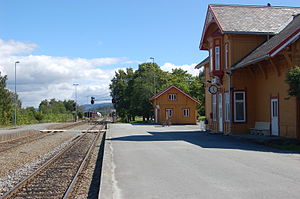Hell Station
|
Hell
|
|
|---|---|

Hell Station platforms.
Photo: Alasdair McLellan |
|
| Location |
Hell, Stjørdal Norway |
| Coordinates | 63°26′46″N 10°53′55″E / 63.44611°N 10.89861°ECoordinates: 63°26′46″N 10°53′55″E / 63.44611°N 10.89861°E |
| Elevation | 3.2 m (10 ft) |
| Operated by | Norwegian State Railways |
| Line(s) |
Nordland Line Meråker Line |
| Distance | 31.4 km (19.5 mi) |
| Platforms | 3 |
| History | |
| Opened | 1881 |
Hell Station (Norwegian: Hell stasjon) is a railway station located in the village of Hell in the Municipality of Stjørdal in the County of Nord-Trøndelag, Norway. It is located at the intersection of the Nordland Line and the Meråker Line.
Hell Station serves:
Both services are operated by Class 92 units by the Norwegian State Railways.
Planned by architect Paul Armin Due, the present station building at Hell Station was opened in 1902. It replaced an older building of 1881, whose architect was Peter Andreas Blix.
The restaurant was taken over by Norsk Spisevognselskap on 1 October 1922, but returned to private operation in 1934.
Due to its name, Hell Station has become a tourist attraction.
The station's freight building still bears the old sign saying Hell Gods-Expedition. In Norwegian, Gods-Expedition (archaic) or godsekspedisjon (modern) means freight service or cargo handling. This sign is a popular photo opportunity for foreign tourists, and especially in the summer months, it is not unusual that foreigners, when discovering the sign, evacuate the train in order to get a photo.
Whilst associated with the religious concept Hell by English-speakers, the name Hell derives from Old Norse hellir, which means cave. The Norwegian equivalent to English hell is hel or, more commonly, helvete (compare with Old English hellewīte).
...
Wikipedia
